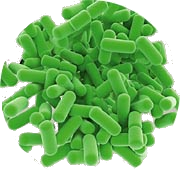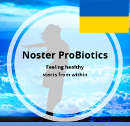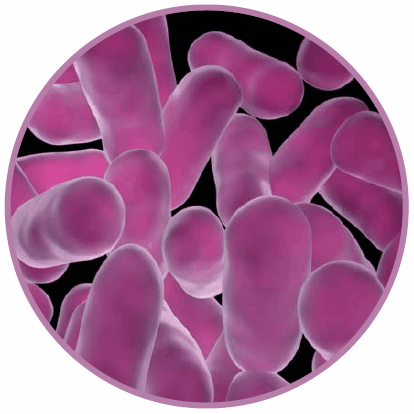Brief description
Lactobacillus rhamnosus, until the genetic research proved otherwise, was thought to be a subspecies of Lactobacillus casei. It is a Gram-positive rod-shaped bacterium that lives in chains. Lactobacillus rhamnosus is a facultatively anaerobic, that is it usually uses oxygen (aerobic) but can survive when there is no oxygen (anaerobic). It is used as a probiotic especially in females as it is common in the female genito-urinary tract.
Lactobacillus rhamnosus can survive the acid of the stomach and bile of the intestine but the are probably transient and don’t form colonies. Its mechanism of action is unknown but it is known to work on many levels.
It is also found in yoghurt and dairy products such as fermented and unpasteurized milk and semi-hard cheese.
From Wikipedia, the free encyclopedia
| Lactobacillus rhamnosus | |
|---|---|
 |
|
| Scientific classification | |
| Domain: | Bacteria |
| Phylum: | Firmicutes |
| Class: | Bacilli |
| Order: | Lactobacillales |
| Family: | Lactobacillaceae |
| Genus: | Lactobacillus |
| Species: | L. rhamnosus |
| Binomial name | |
| Lactobacillus rhamnosus (Hansen 1968) Collins et al. 1989 |
|
Description of the Lactobacillus rhamnosus
It is facultatively anaerobic, able to live with or without oxygen. It is rod-shaped and forms chains but does not seem to colonise the GIT but and is considered to be transient, so it has to be constantly replaced. It is particularly useful in women found naturally in their genito-urinary tracts. It has a very wide spectrum of action but the mechanisms are not understood.
Health Benefits of Lactobacillus rhamnosus in Brief.
The biggest health benefit for women is in their genito-urinary tracts for the treatment of bacterial vaginosis (or “BV”). They help to regain a balance in bacterial and fungal infections during an active infection.
Therapeutic uses of Lactobacillus rhamnosus
Allergies.
As the model of our immune system indicates (How our immune system works), probiotics are essential in producing the anti-inflammatory, regulatory, response.
Peanut Allergies
Lactobacillus rhamnosus will stop a peanut allergy in 80% of cases.
Anxiety
A report on the 29th August 2011 in the Proceedings of the National Academy of Sciences showed the effect of the bacterium on the GABA neurotransmitter receptors. In mice, it reduced the level of anxiety and the levels of the stress hormones.
Atopic dermatitis, eczema
Again, our immune system model predicts that Lactobacillus rhamnosus would be an effective treatment and prevention of eczema and atopic dermatitis. Children with allergies, often Caesar babies, have been effectively treated for eczema and has shown to have a long term prevention effect as well.
Diarrhoea
Lactobacillus rhamnosus is beneficial for the prevention and treatment of diarrhoea in adults and children. In children, it is often used for the prevention of rotavirus diarrhoea.
Due to Antibiotics
It should be used whenever an antibiotic is prescribed to prevent diarrhoea in children and adults, as well as fungal overgrowths.
Chemotherapy
Used to alleviate the diarrhoea caused by chemotherapy.
Travellers
A great way to prevent travellers diarrhoea when in a foreign country.
Hospital stays
Nothing to do with hospital food, but extended stays in hospital can result in diarrhoea.
Intestinal tract permeability (Leaky Gut)
In children with IBS, irritable bowel syndrome Lactobacillus rhamnosus reduced the leaky gut effect. In alcohol-related leaky gut, intestinal permeability due to the effects of alcohol, L. rhamnosus was also very effective.
Gastrointestinal carriage of vancomycin-resistant Enterococcus (VRE)
This is a problem in renal patients, in 2005 Lactobacillus rhamnosus was successfully used as a treatment.
Respiratory tract infections
Lactobacillus rhamnosus is particularly effective in children as a treatment and as prevention.
Urogenital tract infections
The Lactobacillus rhamnosus produces a surfactant, a substance that reduces the surface tension of water, which prevents pathogens, disease-producing bacteria, from attaching to the bladder and vaginal walls.
In the November 2009 issue of Renal and Urology News, postmenopausal women taking a daily dose of Lactobacillus rhamnosus had effective relief from chronic urinary tract infections. Trimethoprim-sulfamethoxazole (Bactrim, Purbac etc) is the standard treatment, in South Africa, it is nitrofurantoin (Macrodantin), but these are antibiotics with all the problems they cause.
Weight loss
The gut bacteria of thin people are significantly different from obese people. In 2003 a paper published in the British Journal of Nutrition showed that women lost twice as much weight when on a probiotic containing Lactobacillus rhamnosus. Interestingly it made no difference in men.
Aids in Dairy Product Digestion Among the Lactose-Intolerant
A 1998 study conducted among dairy-sensitive research subjects showed that the subjects who consumed milk with L. rhamnosus GG did not exhibit the inflammatory response that occurred with the subjects who drank milk without the probiotic. Also, the L. rhamnosus appeared to enhance the immune system in the test subjects in whom the probiotic-enhanced milk did not generate an inflammatory reaction. (5)
Other conditions that are treated by Lactobacillus rhamnosus
Colic in babies
A very effective aid in treating colic in babies
Other conditions include treating irritable bowel syndrome, ulcerative colitis, Crohn’s disease, lactose intolerance, or vaginal yeast infections.
It lowers the risk of lung infections in children who attend daycare centres.
Although these have no proven research there is patient supplied feedback for the following, treating cold sores, urinary tract infections, high cholesterol, indigestion, cold symptoms, and boosting the immune system.


Are we able to purchase this probiotic on its own? I am using 9 strain probiotic…but would prefer this one on its own.
Not sure what you mean. If you want to purchase just the Lactobacillus rhmanosus alone then I don’t see any manufacturer offering just that. We offer a 10 strain probiotic.